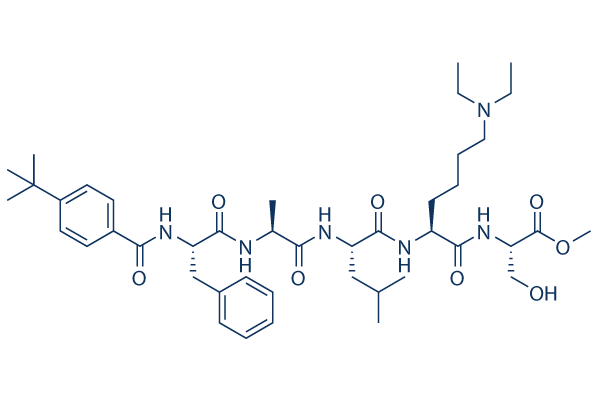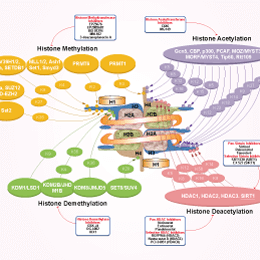
- Bioactive Compounds
- By Signaling Pathways
- PI3K/Akt/mTOR
- Epigenetics
- Methylation
- Immunology & Inflammation
- Protein Tyrosine Kinase
- Angiogenesis
- Apoptosis
- Autophagy
- ER stress & UPR
- JAK/STAT
- MAPK
- Cytoskeletal Signaling
- Cell Cycle
- TGF-beta/Smad
- DNA Damage/DNA Repair
- Compound Libraries
- Popular Compound Libraries
- Customize Library
- Clinical and FDA-approved Related
- Bioactive Compound Libraries
- Inhibitor Related
- Natural Product Related
- Metabolism Related
- Cell Death Related
- By Signaling Pathway
- By Disease
- Anti-infection and Antiviral Related
- Neuronal and Immunology Related
- Fragment and Covalent Related
- FDA-approved Drug Library
- FDA-approved & Passed Phase I Drug Library
- Preclinical/Clinical Compound Library
- Bioactive Compound Library-I
- Bioactive Compound Library-Ⅱ
- Kinase Inhibitor Library
- Express-Pick Library
- Natural Product Library
- Human Endogenous Metabolite Compound Library
- Alkaloid Compound LibraryNew
- Angiogenesis Related compound Library
- Anti-Aging Compound Library
- Anti-alzheimer Disease Compound Library
- Antibiotics compound Library
- Anti-cancer Compound Library
- Anti-cancer Compound Library-Ⅱ
- Anti-cancer Metabolism Compound Library
- Anti-Cardiovascular Disease Compound Library
- Anti-diabetic Compound Library
- Anti-infection Compound Library
- Antioxidant Compound Library
- Anti-parasitic Compound Library
- Antiviral Compound Library
- Apoptosis Compound Library
- Autophagy Compound Library
- Calcium Channel Blocker LibraryNew
- Cambridge Cancer Compound Library
- Carbohydrate Metabolism Compound LibraryNew
- Cell Cycle compound library
- CNS-Penetrant Compound Library
- Covalent Inhibitor Library
- Cytokine Inhibitor LibraryNew
- Cytoskeletal Signaling Pathway Compound Library
- DNA Damage/DNA Repair compound Library
- Drug-like Compound Library
- Endoplasmic Reticulum Stress Compound Library
- Epigenetics Compound Library
- Exosome Secretion Related Compound LibraryNew
- FDA-approved Anticancer Drug LibraryNew
- Ferroptosis Compound Library
- Flavonoid Compound Library
- Fragment Library
- Glutamine Metabolism Compound Library
- Glycolysis Compound Library
- GPCR Compound Library
- Gut Microbial Metabolite Library
- HIF-1 Signaling Pathway Compound Library
- Highly Selective Inhibitor Library
- Histone modification compound library
- HTS Library for Drug Discovery
- Human Hormone Related Compound LibraryNew
- Human Transcription Factor Compound LibraryNew
- Immunology/Inflammation Compound Library
- Inhibitor Library
- Ion Channel Ligand Library
- JAK/STAT compound library
- Lipid Metabolism Compound LibraryNew
- Macrocyclic Compound Library
- MAPK Inhibitor Library
- Medicine Food Homology Compound Library
- Metabolism Compound Library
- Methylation Compound Library
- Mouse Metabolite Compound LibraryNew
- Natural Organic Compound Library
- Neuronal Signaling Compound Library
- NF-κB Signaling Compound Library
- Nucleoside Analogue Library
- Obesity Compound Library
- Oxidative Stress Compound LibraryNew
- Plant Extract Library
- Phenotypic Screening Library
- PI3K/Akt Inhibitor Library
- Protease Inhibitor Library
- Protein-protein Interaction Inhibitor Library
- Pyroptosis Compound Library
- Small Molecule Immuno-Oncology Compound Library
- Mitochondria-Targeted Compound LibraryNew
- Stem Cell Differentiation Compound LibraryNew
- Stem Cell Signaling Compound Library
- Natural Phenol Compound LibraryNew
- Natural Terpenoid Compound LibraryNew
- TGF-beta/Smad compound library
- Traditional Chinese Medicine Library
- Tyrosine Kinase Inhibitor Library
- Ubiquitination Compound Library
-
Cherry Picking
You can personalize your library with chemicals from within Selleck's inventory. Build the right library for your research endeavors by choosing from compounds in all of our available libraries.
Please contact us at [email protected] to customize your library.
You could select:
- Antibodies
- Bioreagents
- qPCR
- 2x SYBR Green qPCR Master Mix
- 2x SYBR Green qPCR Master Mix(Low ROX)
- 2x SYBR Green qPCR Master Mix(High ROX)
- Protein Assay
- Protein A/G Magnetic Beads for IP
- Anti-Flag magnetic beads
- Anti-Flag Affinity Gel
- Anti-Myc magnetic beads
- Anti-HA magnetic beads
- Magnetic Separator
- Poly DYKDDDDK Tag Peptide lyophilized powder
- Protease Inhibitor Cocktail
- Protease Inhibitor Cocktail (EDTA-Free, 100X in DMSO)
- Phosphatase Inhibitor Cocktail (2 Tubes, 100X)
- Cell Biology
- Cell Counting Kit-8 (CCK-8)
- Animal Experiment
- Mouse Direct PCR Kit (For Genotyping)
- New Products
- Contact Us
UNC3866
UNC3866 is a potent antagonist of the methyllysine (Kme) reading function of the Polycomb CBX and CDY families of chromodomains. UNC3866 binds the chromodomains of CBX4 and CBX7 most potently, with a K(d) of ∼100 nM for each, and is 6- to 18-fold selective as compared to seven other CBX and CDY chromodomains.

UNC3866 Chemical Structure
CAS No. 1872382-47-2
Purity & Quality Control
Batch:
Purity:
98.49%
98.49
UNC3866 Related Products
Signaling Pathway
Biological Activity
| Description | UNC3866 is a potent antagonist of the methyllysine (Kme) reading function of the Polycomb CBX and CDY families of chromodomains. UNC3866 binds the chromodomains of CBX4 and CBX7 most potently, with a K(d) of ∼100 nM for each, and is 6- to 18-fold selective as compared to seven other CBX and CDY chromodomains. | ||||||
|---|---|---|---|---|---|---|---|
| Targets |
|
| In vitro | ||||
| In vitro | UNC3866 is a potent antagonist of the CBX7-H3 interaction(IC50 = 66±1.2 nM). The affinity of UNC3866 for CBX2, -4, -6 and -8 is also surprisingly well correlated with the percent sequence identity of each chromodomain relative to that of CBX7. UNC3866 is equipotent for CBX4, which is most similar to CBX7, while it is 18-, 6- and 12-fold selective for CBX4/7 over CBX2, -6 and -8, respectively. Additionally, UNC3866 is 65-fold selective for CBX4/7 over CDY1 and 9-fold selective for CBX4/7 over CDYL1b and CDYL2. UNC3866 antagonizes PRC1 chromodomains in cells. Thought the permeability of UNC3866 is low, it is sufficiently cell permeable and stable to evaluate its ability to engage and antagonize the functions of its chromodomain targets in cells. UNC3866 inhibits PC3 cell proliferation [1]. | |||
|---|---|---|---|---|
| Cell Research | Cell lines | PC3 cells | ||
| Concentrations | 30 μM | |||
| Incubation Time | 24 hours | |||
| Method | PC3 cells are seeded at 200 cells/well into 24-well plates. Cells are allowed to adhere overnight. The media (DMEM supplemented with 10 % FBS) is then exchanged with fresh media containing DMSO, UNC3866 or UNC4219. On day three, the media are exchanged with fresh media containing DMSO, UNC3866 or UNC4219. For dose-response studies, the EC50 is derived from a six-point titration ranging from 100 μM to 0.4 μM of UNC3866 or UNC4219. At day 0, 3 or 6, cells are fixed with ice-cold methanol for 30 sec. and rehydrated with PBS. Nuclei of the cells are stained with DAPI (0.05 μg/ml) and numerated using High Content Microscopy. For dose-response studies, the cell count of UNC3866- or UNC4219-treated cells is normalized to the average cell count of DMSO-treated cells. The EC50 is calculated using the "log[inhibitor] vs. the normalized response -- Variable slope" equation in GraphPad Prism 5. |
|||
| In Vivo | ||
| In vivo | UNC3866 is the predominant species in plasma at all time points tested relative to UNC4007 and shows 25% bioavailability and moderate clearance. While these PK results are promising for a peptidic compound, the use of UNC3866 in vivo may be limited because of the high circulating levels required for intracellular target engagement due to its poor cell permeability. The potential utility of UNC3866 at higher doses for in vivo experiments is currently under investigation[1]. | |
|---|---|---|
| Animal Research | Animal Models | swiss albino mice |
| Dosages | 10 mg/kg | |
| Administration | i.p. | |
Chemical Information & Solubility
| Molecular Weight | 795.02 | Formula | C43H66N6O8 |
| CAS No. | 1872382-47-2 | SDF | Download UNC3866 SDF |
| Smiles | CCN(CC)CCCCC(C(=O)NC(CO)C(=O)OC)NC(=O)C(CC(C)C)NC(=O)C(C)NC(=O)C(CC1=CC=CC=C1)NC(=O)C2=CC=C(C=C2)C(C)(C)C | ||
| Storage (From the date of receipt) | |||
|
In vitro |
DMSO : 100 mg/mL ( (125.78 mM) Moisture-absorbing DMSO reduces solubility. Please use fresh DMSO.) Ethanol : 100 mg/mL Water : Insoluble |
Molecular Weight Calculator |
|
In vivo Add solvents to the product individually and in order. |
In vivo Formulation Calculator |
||||
Preparing Stock Solutions
Molarity Calculator
In vivo Formulation Calculator (Clear solution)
Step 1: Enter information below (Recommended: An additional animal making an allowance for loss during the experiment)
mg/kg
g
μL
Step 2: Enter the in vivo formulation (This is only the calculator, not formulation. Please contact us first if there is no in vivo formulation at the solubility Section.)
% DMSO
%
% Tween 80
% ddH2O
%DMSO
%
Calculation results:
Working concentration: mg/ml;
Method for preparing DMSO master liquid: mg drug pre-dissolved in μL DMSO ( Master liquid concentration mg/mL, Please contact us first if the concentration exceeds the DMSO solubility of the batch of drug. )
Method for preparing in vivo formulation: Take μL DMSO master liquid, next addμL PEG300, mix and clarify, next addμL Tween 80, mix and clarify, next add μL ddH2O, mix and clarify.
Method for preparing in vivo formulation: Take μL DMSO master liquid, next add μL Corn oil, mix and clarify.
Note: 1. Please make sure the liquid is clear before adding the next solvent.
2. Be sure to add the solvent(s) in order. You must ensure that the solution obtained, in the previous addition, is a clear solution before proceeding to add the next solvent. Physical methods such
as vortex, ultrasound or hot water bath can be used to aid dissolving.
Tech Support
Answers to questions you may have can be found in the inhibitor handling instructions. Topics include how to prepare stock solutions, how to store inhibitors, and issues that need special attention for cell-based assays and animal experiments.
Tel: +1-832-582-8158 Ext:3
If you have any other enquiries, please leave a message.
* Indicates a Required Field
Tags: buy UNC3866 | UNC3866 supplier | purchase UNC3866 | UNC3866 cost | UNC3866 manufacturer | order UNC3866 | UNC3866 distributor







































